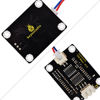TDS Sensor kit
TDS sensor kit is compatible with Arduino controllers, plug and play, easy to use.It can be applied to measure TDS value of the water, to reflect the cleanliness of the water.
TDS (Total Dissolved Solids) indicates that how many milligrams of soluble solids dissolved in one liter of water. In general, the higher the TDS value, the more soluble solids dissolved in water, and the less clean the water is.Therefore, the TDS value can be used as one of the references for reflecting the cleanliness of water.Measuring the TDS value in the water is to measure the total amount of various organic or inorganic substances dissolved in water, in the unit of ppm or milligrams per liter (mg/l).
Its Electrode can measure conductive materials, such as suspended solids, heavy metals and conductive ions in water.
The module comes with four 3.2mm fixed holes, easy to mount on any other devices.
TDS Meter:
· Input Voltage: DC 3.3 ~ 5.5V
· Output Voltage: 0 ~ 2.3V
· Working Current: 3 ~ 6mA
· TDS Measurement Range: 0 ~ 1000ppm
· TDS Measurement Accuracy: ± 10% F.S. (25 ℃)
· Module Interface: XH2.54-3P
· Electrode Interface: XH2.54-2P
TDS Probe:
· Number of Needle: 2
· Total Length: 60cm
· Connection Interface: XH2.54-2P
· Color: White
· Other: Waterproof Probe
Turbidity Sensor V1.0
The keyestudio turbidity sensor detects water quality by measuring level of turbidity.
The principle is to convert the current signal itself into the voltage output through the circuit.
Its detection range is 0%-3.5% (0-4550NTU), with an error range of ±05%F*S.
When using, measure the voltage value of sensor’s Signal end; then work out the water’s turbidity by simple calculation formula.
This turbidity sensor have both analog and digital signal output modes.
The module has a slide switch. When slide the switch to A end, connect the signal end to analog port, can read the analog value to calculate the output voltage so as to get the turbidity degree of water. If slide to D end, connect signal end to digital port, can detect the water whether is turbidity by outputting HIGH or LOW level.
You can turn the blue potentiometer on the sensor to adjust the sensitivity of sensor.
Turbidity sensors can be used in measurement of water quality in rivers and streams, wastewater and effluent measurements, sediment transport research and laboratory measurements.
Note: the top of probe is not water-proof; can only place the transparent bottom part into water.
Description://wiki.keyestudio.com/KS0414_Keyestudio_Turbidity_Sensor_V1.0







































